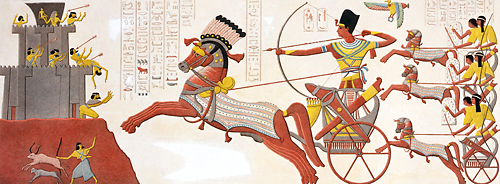Ramses << RAM seez >> II was one of the most celebrated kings of ancient Egypt. He reigned from about 1279 to 1213 B.C. While young, Ramses served for a time as prince regent (substitute ruler) under his father, Seti I. From the fourth year of his own reign, Ramses conducted military campaigns in northern Syria to halt the expansion of the Hittite kingdom. A major battle against the Hittites at Kadesh (also spelled Qadesh) in the fifth year of his reign was indecisive. But the personal bravery of Ramses during the battle was recorded in texts and artwork throughout Egypt and the Egyptian colony of Nubia. By about 1259, Egypt had made a formal peace treaty and developed close diplomatic ties with a weakened Hittite kingdom.

Ramses was a great builder. He constructed a new capital, Per-Ramses (City of Ramses), in the Nile Delta. He continued his father’s work on temples at Abydos and Karnak. His building projects appeared throughout Egypt and Nubia. Ramses also built the famous Temples of Abu Simbel, which are dedicated to the worship of him as a living god. Ramses outlived his first dozen heirs. A tomb for some of his sons has undergone some excavation in the Valley of the Kings in central Egypt. His mummy is preserved in the Egyptian Museum in Cairo.
Loading the player...Valley of the Kings in Egypt
